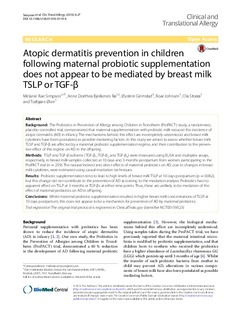| dc.contributor.author | Simpson, Melanie Rae | |
| dc.contributor.author | Rø, Anne Dorthea | |
| dc.contributor.author | Grimstad, Øystein | |
| dc.contributor.author | Johnsen, Roar | |
| dc.contributor.author | Storrø, Ola | |
| dc.contributor.author | Øien, Torbjørn | |
| dc.date.accessioned | 2016-09-08T13:45:55Z | |
| dc.date.accessioned | 2016-09-09T08:25:13Z | |
| dc.date.available | 2016-09-08T13:45:55Z | |
| dc.date.available | 2016-09-09T08:25:13Z | |
| dc.date.issued | 2016 | |
| dc.identifier.citation | Clinical and Translational Allergy 2016 | nb_NO |
| dc.identifier.issn | 2045-7022 | |
| dc.identifier.uri | http://hdl.handle.net/11250/2405653 | |
| dc.description.abstract | Background:
The Probiotics in Prevention of Allergy among Children in Trondheim (ProPACT) study, a randomised, placebo controlled trial, demonstrated that maternal supplementation with probiotic milk reduced the incidence of atopic dermatitis (AD) in infancy. The mechanisms behind this effect are incompletely understood and breast milk cytokines have been postulated as possible mediating factors. In this study we aimed to assess whether breast milk TLSP and TGF-β are affected by a maternal probiotic supplementation regime, and their contribution to the preventive effect of this regime on AD in the offspring.
Methods:
TSLP and TGF-β isoforms (TGF-β1, TGF-β2 and TGF-β3) were measured using ELISA and multiplex assays, respectively, in breast milk samples collected at 10 days and 3 months postpartum from women participating in the ProPACT trial (n = 259). The natural indirect and direct effects of maternal probiotics on AD, due to changes in breast milk cytokines, were estimated using causal mediation techniques.
Results:
Probiotic supplementation tend to lead to high levels of breast milk TSLP at 10 days postpartum (p = 0.062), but this change did not contribute to the prevention of AD according to the mediation analysis. Probiotics had no apparent effect on TSLP at 3 months or TGF-βs at either time points. Thus, these are unlikely to be mediators of the effect of maternal probiotics on AD in offspring.
Conclusions:
Whilst maternal probiotic supplementation resulted in higher breast milk concentrations of TLSP at 10 days postpartum, this does not appear to be a mechanism for prevention of AD by maternal probiotics. | nb_NO |
| dc.language.iso | eng | nb_NO |
| dc.publisher | BioMed Central | nb_NO |
| dc.rights | Navngivelse 3.0 Norge | * |
| dc.rights.uri | http://creativecommons.org/licenses/by/3.0/no/ | * |
| dc.title | Atopic dermatitis prevention in children following maternal probiotic supplementation does not appear to be mediated by breast milk TSLP or TGF-β. | nb_NO |
| dc.type | Journal article | nb_NO |
| dc.type | Peer reviewed | nb_NO |
| dc.date.updated | 2016-09-08T13:45:55Z | |
| dc.source.journal | Clinical and Translational Allergy | nb_NO |
| dc.identifier.doi | 10.1186/s13601-016-0119-6 | |
| dc.identifier.cristin | 1370053 | |
| dc.description.localcode | © The Author(s) 2016. This article is distributed under the terms of the Creative Commons Attribution 4.0 International License (http://creativecommons.org/licenses/by/4.0/), which permits unrestricted use, distribution, and reproduction in any medium, provided you give appropriate credit to the original author(s) and the source, provide a link to the Creative Commons license, and indicate if changes were made. The Creative Commons Public Domain Dedication waiver (http://creativecommons.org/publicdomain/zero/1.0/) applies to the data made available in this article, unless otherwise stated. | nb_NO |

